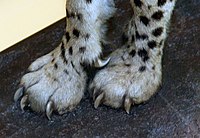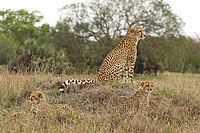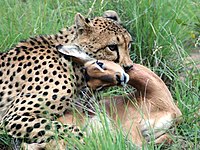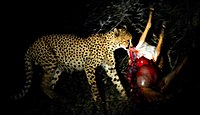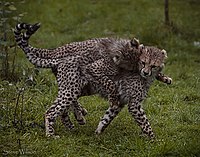Cheetah
| Cheetah Temporal range: Pleistocene–Present
| |
|---|---|

| |
| Male cheetah, in South Africa | |
| Scientific classification | |
| Domain: | Eukaryota |
| Kingdom: | Animalia |
| Phylum: | Chordata |
| Class: | Mammalia |
| Order: | Carnivora |
| Suborder: | Feliformia |
| Family: | Felidae |
| Subfamily: | Felinae |
| Genus: | Acinonyx |
| Species: | A. jubatus
|
| Binomial name | |
| Acinonyx jubatus (Schreber, 1775)
| |
| Subspecies | |
|
List
| |

| |
| The range of the cheetah as of 2015[1] | |
| Synonyms[2] | |
|
List
| |
The cheetah (Acinonyx jubatus) is a large cat and the fastest land animal. It has a tawny to creamy white or pale buff fur that is marked with evenly spaced, solid black spots. The head is small and rounded, with a short snout and black tear-like facial streaks. It reaches 67–94 cm (26–37 in) at the shoulder, and the head-and-body length is between 1.1 and 1.5 m (3 ft 7 in and 4 ft 11 in). Adults weigh between 21 and 72 kg (46 and 159 lb). The cheetah is capable of running at 93 to 104 km/h (58 to 65 mph);[3][4] it has evolved specialized adaptations for speed, including a light build, long thin legs and a long tail.
The cheetah was first
, and hilly desert terrain.The cheetah lives in three main social groups: females and their cubs, male "coalitions", and solitary males. While females lead a nomadic life searching for prey in large home ranges, males are more sedentary and instead establish much smaller territories in areas with plentiful prey and access to females. The cheetah is active during the day, with peaks during dawn and dusk. It feeds on small- to medium-sized prey, mostly weighing under 40 kg (88 lb), and prefers medium-sized ungulates such as impala, springbok and Thomson's gazelles. The cheetah typically stalks its prey within 60–100 m (200–330 ft) before charging towards it, trips it during the chase and bites its throat to suffocate it to death. It breeds throughout the year. After a gestation of nearly three months, females give birth to a litter of three or four cubs. Cheetah cubs are highly vulnerable to predation by other large carnivores. They are weaned at around four months and are independent by around 20 months of age.
The cheetah is threatened by
Etymology
The vernacular name "cheetah" is derived from
A few old generic names such as Cynailurus and Cynofelis allude to the similarities between the cheetah and
Taxonomy
In 1777,
In the 19th and 20th centuries, several cheetah specimens were described; some were proposed as subspecies. An example is the South African specimen known as the "woolly cheetah", named for its notably dense fur—this was described as a new species (Felis lanea) by Philip Sclater in 1877,[17] but the classification was mostly disputed.[18] There has been considerable confusion in the nomenclature of cheetahs and leopards (Panthera pardus) as authors often confused the two; some considered "hunting leopards" an independent species, or equal to the leopard.[19][20]
Subspecies
In 1975, five cheetah subspecies were considered
| Subspecies | Details | Image |
|---|---|---|
| Southeast African cheetah (A. j. jubatus) (Schreber, 1775), syn. A. j. raineyi Heller, 1913[24] | The nominate subspecies;[23] it genetically diverged from the Asiatic cheetah 67,000–32,000 years ago.[22] As of 2016, the largest population of nearly 4,000 individuals is sparsely distributed in Angola, Botswana, Mozambique, Namibia, South Africa and Zambia.[25]
|

|
| Asiatic cheetah (A. j. venaticus) Griffith, 1821[26] | This subspecies is confined to central Iran, and is the only surviving cheetah population in Asia.[27] As of 2022, only 12 individuals were estimated to survive in Iran, nine of which are males and three of which are females.[28] | 
|
| Northeast African cheetah (A. j. soemmeringii) Fitzinger, 1855[29] | This subspecies occurs in the northern Central African Republic, Chad, Ethiopia and South Sudan in small and heavily fragmented populations; in 2016, the largest population of 238 individuals occurred in the northern CAR and southeastern Chad. It diverged genetically from the southeast African cheetah 72,000–16,000 years ago.[22] | 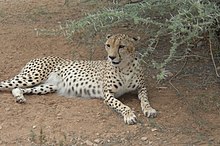
|
| Northwest African cheetah (A. j. hecki) Hilzheimer, 1913[30] | This subspecies occurs in Algeria, Benin, Burkina Faso, Mali and Niger.[1] In 2016, the largest population of 191 individuals occurred in Adrar des Ifoghas, Ahaggar and Tassili n'Ajjer in south-central Algeria and northeastern Mali.[27] It is listed as Critically Endangered on the IUCN Red List.[31] |
Phylogeny and evolution
| ||||||||||||||||||||||||||||||||||||||||||||||||
| The Puma lineage of the family Felidae, depicted along with closely related genera[32] |
The cheetah's closest relatives are the
The oldest cheetah fossils, excavated in eastern and southern Africa, date to 3.5–3 mya; the earliest known specimen from South Africa is from the lowermost deposits of the Silberberg Grotto (
Extinct North American cheetah-like cats had historically been classified in Felis, Puma or Acinonyx; two such species, F. studeri and F. trumani, were considered to be closer to the puma than the cheetah, despite their close similarities to the latter. Noting this, palaeontologist Daniel Adams proposed Miracinonyx, a new subgenus under Acinonyx, in 1979 for the North American cheetah-like cats;[37] this was later elevated to genus rank.[38] Adams pointed out that North American and Old World cheetah-like cats may have had a common ancestor, and Acinonyx might have originated in North America instead of Eurasia.[37] However, subsequent research has shown that Miracinonyx is phylogenetically closer to the cougar than the cheetah;[39] the similarities to cheetahs have been attributed to parallel evolution.[32]
The three species of the Puma lineage may have had a common ancestor during the
Genetics
The
The low genetic diversity is thought to have been created by two
King cheetah

The king cheetah is a variety of cheetah with a rare
In 1927, Pocock described these individuals as a new species by the name of Acinonyx rex ("king cheetah").
In 1981, two female cheetahs that had mated with a wild male from Transvaal at the
Characteristics

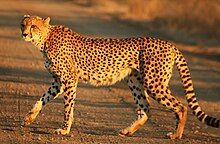
The cheetah is a lightly built, spotted cat characterised by a small rounded head, a short
The coat is typically tawny to creamy white or pale buff (darker in the mid-back portion).[10][62] The chin, throat and underparts of the legs and the belly are white and devoid of markings. The rest of the body is covered with around 2,000 evenly spaced, oval or round solid black spots, each measuring roughly 3–5 cm (1.2–2.0 in).[60][66][67] Each cheetah has a distinct pattern of spots which can be used to identify unique individuals.[63] Besides the clearly visible spots, there are other faint, irregular black marks on the coat.[66] Newly born cubs are covered in fur with an unclear pattern of spots that gives them a dark appearance—pale white above and nearly black on the underside.[12] The hair is mostly short and often coarse, but the chest and the belly are covered in soft fur; the fur of king cheetahs has been reported to be silky.[10][68] There is a short, rough mane, covering at least 8 cm (3.1 in) along the neck and the shoulders; this feature is more prominent in males. The mane starts out as a cape of long, loose blue to grey hair in juveniles.[60][68] Melanistic cheetahs are rare and have been seen in Zambia and Zimbabwe.[66] In 1877–1878, Sclater described two partially albino specimens from South Africa.[60]
The head is small and more rounded compared to other
The cheetah is superficially similar to the leopard, which has a larger head, fully retractable claws, rosettes instead of spots, lacks tear streaks and is more muscular.[65][72] Moreover, the cheetah is taller than the leopard. The serval also resembles the cheetah in physical build, but is significantly smaller, has a shorter tail and its spots fuse to form stripes on the back.[73] The cheetah appears to have evolved convergently with canids in morphology and behaviour; it has canine-like features such as a relatively long snout, long legs, a deep chest, tough paw pads and blunt, semi-retractable claws.[74][75] The cheetah has often been likened to the greyhound, as both have similar morphology and the ability to reach tremendous speeds in a shorter time than other mammals,[68][71] but the cheetah can attain much higher maximum speeds.[76]
Internal anatomy
Sharply contrasting with the other big cats in its morphology, the cheetah shows several specialized adaptations for prolonged chases to catch prey at some of the fastest speeds reached by land animals.
The cheetah resembles the smaller cats in cranial features, and in having a long and flexible spine, as opposed to the stiff and short one in other large felids.[2] The roughly triangular skull has light, narrow bones and the sagittal crest is poorly developed, possibly to reduce weight and enhance speed. The mouth can not be opened as widely as in other cats given the shorter length of muscles between the jaw and the skull.[60][65] A study suggested that the limited retraction of the cheetah's claws may result from the earlier truncation of the development of the middle phalanx bone in cheetahs.[77]
The cheetah has a total of 30 teeth; the
Speed and acceleration
The cheetah is the world's
Cheetahs equipped with
One stride of a galloping cheetah measures 4 to 7 m (13 to 23 ft); the stride length and the number of jumps increases with speed.[60] During more than half the duration of the sprint, the cheetah has all four limbs in the air, increasing the stride length.[100] Running cheetahs can retain up to 90% of the heat generated during the chase. A 1973 study suggested the length of the sprint is limited by excessive build-up of body heat when the body temperature reaches 40–41 °C (104–106 °F). However, a 2013 study recorded the average temperature of cheetahs after hunts to be 38.6 °C (101.5 °F), suggesting high temperatures need not cause hunts to be abandoned.[101][102]
The running speed of 71 mph (114 km/h) of the cheetah was obtained as an result of a single run of one individual by dividing the distance traveled for time spent. The run lasted 2.25 seconds and was supposed to have been 73 m (240 ft) long, but was later found to have been 59 m (194 ft) long. It was therefore discredited for a faulty method of measurement.[103] Cheetahs have subsequently been measured at running at a speed of 64 mph (103 km/h) as an average of three runs including in opposite direction, for a single individual, over a marked 200 m (220 yd) course, even starting the run 18 m (59 ft) behind the start line, starting the run already running on the course. Again dividing the distance by time, but this time to determine the maximum sustained speed, completing the runs in an average time of 7 seconds. Being a more accurate method of measurement, this test was made in 1965 but published in 1997.[4] Subsequently, with GPS-IMU collars, running speed was measured for wild cheetahs during hunts with turns and maneuvers, and the maximum speed recorded was 58 mph (93 km/h) sustained for 1–2 seconds. The speed was obtained by dividing the length by the time between footfalls of a stride.[3] Cheetahs can go from 0 to 97 km/h (0 to 60 mph) in less than 3 seconds.[104]
There are indirect ways to realize how fast are cheetah running. One case is known of a cheetah that overtook a young male Pronghorn. Cheetahs can overtake a running antelope with head start of 140 m (150 yd). Both animals are assumed to be clocked at 80 km/h (50 mph) by speedometer reading when running alongside a vehicle at full gallop.[103] Cheetahs can easily capture gazelles at full gallop, clocked at 70–80 km/h (43–50 mph).[105]
The physiological reasons for speed in cheetahs are:
- A tibia and radius longer than the femur and humerus (Femorotibial index: 101.9–105; Humeroradial index: 100.1–103.3).[33][38][106][107]
- Small head and long lumbar region of the spine, 36.8% of the presacral vertebral column.[33][106][38]
- Elongated and slender long bones of the limbs in general (Especially tibia and radius), as well as the pelvis, specially the ischium.[12][106][91]
- A cool nose and enlarged respiratory passages that allow it to inhale and exhale more air with each breath and helping to dissipate body heat.[12]
- A higher concentration of fast-twitch muscle fibers than other cats and animals in general.[12][108][109][104]
- Most of the locomotor muscle mass is concentrated proximally close to the body in shoulders, thighs and spine, and is reduced in shins and forearms. Long tendons finish off the distal locomotor muscles.[12][91]
- Muscular hindlimbs form 19.8 % of the body mass, whereas forelimbs form 15.1 %.[91][110]
Ecology and behaviour
Cheetahs are active mainly during the day,
Social organisation
Cheetahs have a flexible and complex
Some males are territorial, and group together for life, forming coalitions that collectively defend a territory which ensures maximum access to females—this is unlike the behaviour of the male lion who mates with a particular group (pride) of females. In most cases, a coalition will consist of brothers born in the same litter who stayed together after weaning, but biologically unrelated males are often allowed into the group; in the Serengeti 30% members in coalitions are unrelated males.[66] If a cub is the only male in a litter he will typically join an existing group, or form a small group of solitary males with two or three other lone males who may or may not be territorial. In the Kalahari Desert around 40% of the males live in solitude.[63][66]
Males in a coalition are affectionate toward each other, grooming mutually and calling out if any member is lost; unrelated males may face some aversion in their initial days in the group. All males in the coalition typically have equal access to kills when the group hunts together, and possibly also to females who may enter their territory.[112] A coalition generally has a greater chance of encountering and acquiring females for mating, however, its large membership demands greater resources than do solitary males.[63][66] A 1987 study showed that solitary and grouped males have a nearly equal chance of coming across females, but the males in coalitions are notably healthier and have better chances of survival than their solitary counterparts.[113]
Home ranges and territories
Unlike many other felids, among cheetahs, females tend to occupy larger areas compared to males.
Males are generally less nomadic than females; often males in coalitions (and sometimes solitary males staying far from coalitions) establish territories.[60][63] Whether males settle in territories or disperse over large areas forming home ranges depends primarily on the movements of females. Territoriality is preferred only if females tend to be more sedentary, which is more feasible in areas with plenty of prey. Some males, called floaters, switch between territoriality and nomadism depending on the availability of females.[66] A 1987 study showed territoriality depended on the size and age of males and the membership of the coalition.[113] The ranges of floaters averaged 777 km2 (300 sq mi) in the Serengeti to 1,464 km2 (565 sq mi) in central Namibia. In the Kruger National Park (South Africa) territories were much smaller. A coalition of three males occupied a territory measuring 126 km2 (49 sq mi), and the territory of a solitary male measured 195 km2 (75 sq mi).[66] When a female enters a territory, the males will surround her; if she tries to escape, the males will bite or snap at her. Generally, the female can not escape on her own; the males themselves leave after they lose interest in her. They may smell the spot she was sitting or lying on to determine if she was in oestrus.[112]
Communication
The cheetah is a vocal felid with a broad repertoire of calls and sounds; the
Listed below are some commonly recorded vocalisations observed in cheetahs:- Chirping: A chirp (or a "stutter-bark") is an intense bird-like call and lasts less than a second. Cheetahs chirp when they are excited, for instance, when gathered around a kill. Other uses include summoning concealed or lost cubs by the mother, or as a greeting or courtship between adults.[115] The cheetah's chirp is similar to the soft roar of the lion, and its churr as the latter's loud roar.[114] A similar but louder call ('yelp') can be heard from up to 2 km (1.2 mi) away; this call is typically used by mothers to locate lost cubs, or by cubs to find their mothers and siblings.[60][62]
- Churring (or churtling): A churr is a shrill, staccato call that can last up to two seconds. Churring and chirping have been noted for their similarity to the soft and loud roars of the lion. It is produced in similar context as chirping, but a study of feeding cheetahs found chirping to be much more common.[68][115]
- Purring: Similar to purring in domestic cats but much louder, it is produced when the cheetah is content, and as a form of greeting or when licking one another.[60][115] It involves continuous sound production alternating between egressive and ingressive airstreams.[118]
- Agonistic sounds: These include bleating, coughing, growling, hissing, meowing and moaning (or yowling). A bleat indicates distress, for instance when a cheetah confronts a predator that has stolen its kill. Growls, hisses and moans are accompanied by multiple, strong hits on the ground with the front paw, during which the cheetah may retreat by a few metres.[114][115][119] A meow, though a versatile call, is typically associated with discomfort or irritation.[114][120]
- Other vocalisations: Individuals can make a gurgling noise as part of a close, amicable interaction.[60] A "nyam nyam" sound may be produced while eating. Apart from chirping, mothers can use a repeated "ihn ihn" is to gather cubs, and a "prr prr" is to guide them on a journey. A low-pitched alarm call is used to warn the cubs to stand still. Bickering cubs can let out a "whirr"—the pitch rises with the intensity of the quarrel and ends on a harsh note.[68][115]
Another major means of communication is by
Touch and visual cues are other ways of signalling in cheetahs. Social meetings involve mutual sniffing of the mouth, anus and genitals. Individuals will groom one another, lick each other's faces and rub cheeks. However, they seldom lean on or rub their flanks against each other. The tear streaks on the face can sharply define expressions at close range. Mothers probably use the alternate light and dark rings on the tail to signal their cubs to follow them.[68]
Diet and hunting
The cheetah is a carnivore that hunts small to medium-sized prey weighing 20 to 60 kg (44 to 132 lb), but mostly less than 40 kg (88 lb). Its primary prey are medium-sized ungulates. They are the major component of the diet in certain areas, such as Dama and Dorcas gazelles in the Sahara, impala in the eastern and southern African woodlands, springbok in the arid savannas to the south and Thomson's gazelle in the Serengeti. Smaller antelopes like the common duiker are frequent prey in the southern Kalahari. Larger ungulates are typically avoided, though nyala, whose males weigh around 120 kg (260 lb), were found to be the major prey in a study in the Phinda Game Reserve. In Namibia cheetahs are the major predators of livestock.[10][60][121] The diet of the Asiatic cheetah consists of chinkara, desert hare, goitered gazelle, urial, wild goats, and livestock; in India cheetahs used to prey mostly on blackbuck.[66][122]
Prey preferences and hunting success vary with the age, sex and number of cheetahs involved in the hunt and on the vigilance of the prey. Generally, only groups of cheetahs (coalitions or mother and cubs) will try to kill larger prey; mothers with cubs especially look out for larger prey and tend to be more successful than females without cubs. Individuals on the periphery of the prey herd are common targets; vigilant prey which would react quickly on seeing the cheetah are not preferred.[47][60][123]
Cheetahs are one of the most iconic
Cheetahs can decelerate dramatically towards the end of the hunt, slowing down from 93 km/h (58 mph) to 23 km/h (14 mph) in just three strides, and can easily follow any twists and turns the prey makes as it tries to flee.
Once the hunt is over, the prey is taken near a bush or under a tree; the cheetah, highly exhausted after the chase, rests beside the kill and pants heavily for five to 55 minutes. Meanwhile, cheetahs nearby, who did not take part in the hunt, might feed on the kill immediately. Groups of cheetah devour the kill peacefully, though minor noises and snapping may be observed.[60] Cheetahs can consume large quantities of food; a cheetah at the Etosha National Park (Namibia) was found to consume as much as 10 kg (22 lb) within two hours.[125] However, on a daily basis, a cheetah feeds on around 4 kg (8.8 lb) meat.[68] Cheetahs, especially mothers with cubs, remain cautious even as they eat, pausing to look around for fresh prey or for predators who may steal the kill.[126]
Cheetahs move their heads from side to side so the sharp carnassial teeth tear the flesh, which can then be swallowed without chewing. They typically begin with the hindquarters, and then progress toward the abdomen and the spine. Ribs are chewed on at the ends, and the limbs are not generally torn apart while eating. Unless the prey is very small, the skeleton is left almost intact after feeding on the meat. Cheetahs might lose up 13-14 % of their kills to larger and stronger carnivores.[105][60] To defend itself or its prey, a cheetah will hold its body low to the ground and snarl with its mouth wide open, the eyes staring threateningly ahead and the ears folded backward. This may be accompanied by moans, hisses and growls, and hitting the ground with the forepaws.[68] Cheetahs have rarely been observed scavenging kills; this may be due to vultures and spotted hyena adroitly capturing and consuming heavy carcasses within a short time.[60][127]
Reproduction and life cycle
Cheetahs are
Urine-marking in males can become more pronounced when a female in their vicinity comes into oestrus. Males, sometimes even those in coalitions, fight among one another to secure access to the female.
After a gestation of nearly three months, a litter of one to eight cubs is born (though those of three to four cubs are more common). Births take place at 20–25 minute intervals in a sheltered place such as thick vegetation. The eyes are shut at birth, and open in four to 11 days. Newborn cubs might spit a lot and make soft churring noises; they start walking by two weeks. Their nape, shoulders and back are thickly covered with long bluish-grey hair, called a mantle, which gives them a mohawk-type appearance; this fur is shed as the cheetah grows older.[68][16] A study suggested that this mane gives a cheetah cub the appearance of a honey badger, and could act as camouflage from attacks by these badgers or predators that tend to avoid them.[133]
Compared to other felids, cheetah cubs are highly vulnerable to several predators during the first few weeks of their life.[134][135] Mothers keep their cubs hidden in dense vegetation for the first two months and nurse in the early morning. The mother is extremely vigilant at this stage; she stays within 1 km (0.62 mi) of the lair, frequently visits her cubs, moves them every five to six days, and remains with them after dark. Despite trying to make minimal noise, she cannot generally defend her litter from predators. Predation is the leading cause of mortality in cheetah cubs; a study showed that in areas with a low density of predators (such as Namibian farmlands) around 70% of the cubs make it beyond the age of 14 months, whereas in areas like the Serengeti National Park, where several large carnivores exist, the survival rate was just 17%. Deaths also occur from starvation if their mothers abandon them, fires, or pneumonia because of exposure to bad weather.[68][112] Generation length of the cheetah is six years.[136]
Cubs start coming out of the lair at two months of age, trailing after their mother wherever she goes. At this point the mother nurses less and brings solid food to the cubs; they retreat away from the carcass in fear initially, but gradually start eating it. The cubs might purr as the mother licks them clean after the meal. Weaning occurs at four to six months. To train her cubs in hunting, the mother will catch and let go of live prey in front of her cubs.[112] Cubs' play behaviour includes chasing, crouching, pouncing and wrestling; there is plenty of agility, and attacks are seldom lethal.[68][112] Playing can improve catching skills in cubs, though the ability to crouch and hide may not develop remarkably.[137]
Cubs as young as six months try to capture small prey like hares and young gazelles. However, they may have to wait until as long as 15 months of age to make a successful kill on their own. At around 20 months, offspring become independent; mothers might have conceived again by then. Siblings may remain together for a few more months before parting ways. While females stay close to their mothers, males move farther off.[68][112][138] The lifespan of wild cheetahs is 14 to 15 years for females, and their reproductive cycle typically ends by 12 years of age; males generally live as long as ten years.[1]
Distribution and habitat
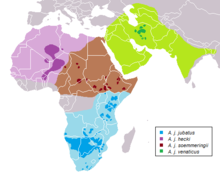

In eastern and southern Africa, the cheetah occurs mostly in savannas like the Kalahari and Serengeti. In central, northern and western Africa, it inhabits arid mountain ranges and valleys; in the harsh climate of the Sahara, it prefers high mountains, which receive more rainfall than the surrounding desert. The vegetation and water resources in these mountains support antelopes. In Iran, it occurs in hilly terrain of deserts at elevations up to 2,000–3,000 m (6,600–9,800 ft), where annual precipitation is generally below 100 mm (3.9 in); the primary vegetation in these areas is thinly distributed shrubs, less than 1 m (3 ft 3 in) tall.[1][66][111]
The cheetah inhabits a variety of ecosystems and appears to be less selective in habitat choice than other felids; it prefers areas with greater availability of prey, good visibility and minimal chances of encountering larger predators. It seldom occurs in tropical forests. It has been reported at the elevation of 4,000 m (13,000 ft). An open area with some cover, such as diffused bushes, is probably ideal for the cheetah because it needs to stalk and pursue its prey over a distance. This also minimises the risk of encountering larger carnivores. The cheetah tends to occur in low densities typically between 0.3 and 3.0 adults per 100 km2 (39 sq mi); these values are 10–30% of those reported for leopards and lions.[1][111]
Historical range
In prehistoric times, the cheetah was distributed throughout Africa, Asia and Europe.
In the past until the mid-20th century, the cheetah ranged across vast stretches in Asia, from the
In 1975, the cheetah population was estimated at 15,000 individuals throughout Sub-Saharan Africa, following the first survey in this region by Norman Myers. The range covered most of eastern and southern Africa, except for the desert region on the western coast of modern-day Angola and Namibia.[144] In the following years, cheetah populations across the region have become smaller and more fragmented as their natural habitat has been modified dramatically.[145]
Present distribution
The cheetah occurs mostly in eastern and southern Africa; its presence in Asia is limited to the central deserts of Iran, though there have been unconfirmed reports of sightings in Afghanistan, Iraq and Pakistan in the last few decades.[1][27] The global population of cheetahs was estimated at nearly 7,100 mature individuals in 2016. The Iranian population appears to have decreased from 60–100 individuals in 2007 to 43 in 2016, distributed in three subpopulations over less than 150,000 km2 (58,000 sq mi) in Iran's central plateau.[25][146] The largest population of nearly 4,000 individuals is sparsely distributed over Angola, Botswana, Mozambique, Namibia, South Africa and Zambia. Another population in Kenya and Tanzania comprises about 1,000 individuals. All other cheetahs occur in small, fragmented groups of less than 100 individuals each. Populations are thought to be declining.[25]
Threats
The cheetah is threatened by several factors, like
Conservation
The cheetah has been classified as
In Africa

Until the 1970s, cheetahs and other carnivores were frequently killed to protect livestock in Africa. Gradually the understanding of cheetah ecology increased and their falling numbers became a matter of concern. The De Wildt Cheetah and Wildlife Centre was set up in 1971 in South Africa to provide care for wild cheetahs regularly trapped or injured by Namibian farmers.[7] By 1987, the first major research project to outline cheetah conservation strategies was underway.[154] The Cheetah Conservation Fund, founded in 1990 in Namibia, put efforts into field research and education about cheetahs on the global platform.[7] The CCF runs a cheetah genetics laboratory, the only one of its kind, in Otjiwarongo (Namibia);[155] "Bushblok" is an initiative to restore habitat systematically through targeted bush thinning and biomass utilisation.[148][156] Several more cheetah-specific conservation programmes have since been established, like Cheetah Outreach in South Africa.[7]
The Global Cheetah Action Plan Workshop in 2002 laid emphasis on the need for a range-wide survey of wild cheetahs to demarcate areas for conservation efforts and on creating awareness through training programs.
The cheetah was reintroduced in Malawi in 2017.[161]
In Asia

In 2001, the Iranian government collaborated with the CCF, the IUCN, Panthera Corporation, UNDP and the Wildlife Conservation Society on the Conservation of Asiatic Cheetah Project (CACP) to protect the natural habitat of the Asiatic cheetah and its prey.[162][163] In 2004, the Iranian Centre for Sustainable Development (CENESTA) conducted an international workshop to discuss conservation plans with local stakeholders.[7] Iran declared 31 August as National Cheetah Day in 2006.[164] The Iranian Cheetah Strategic Planning meet in 2010 formulated a five-year conservation plan for Asiatic cheetahs.[7] The CACP Phase II was implemented in 2009, and the third phase was drafted in 2018.[165]
During the early 2000s scientists from the
Interaction with humans
Taming

The cheetah shows little aggression toward humans, and can be tamed easily, as it has been since antiquity.
In comparison, theories of the cheetah's taming in Egypt are stronger and include timelines proposed on this basis.[178] Mafdet, one of the ancient Egyptian deities worshiped during the First Dynasty (3100–2900 BC), was sometimes depicted as a cheetah. Ancient Egyptians believed the spirits of deceased pharaohs were taken away by cheetahs.[176] Reliefs in the Deir el-Bahari temple complex tell of an expedition by Egyptians to the Land of Punt during the reign of Hatshepsut (1507–1458 BC) that fetched, among other things, animals called "panthers". During the New Kingdom (16th to 11th centuries BC), cheetahs were common pets for royalty, who adorned them with ornate collars and leashes.[178] The Egyptians would use their dogs to bring the concealed prey out in the open, after which a cheetah would be set upon it to kill it. Rock carvings depicting cheetahs dating back to 2000–6000 years ago have been found in Twyfelfontein; little else has been discovered in connection to the taming of cheetahs (or other cats) in southern Africa.[176]
Hunting cheetahs are known in
In eastern Asia, records are confusing as regional names for the leopard and the cheetah may be used interchangeably. The earliest depiction of cheetahs from eastern Asia dates back to the
In captivity
The first cheetah to be brought into captivity in a zoo was at the Zoological Society of London in 1829. Early captive cheetahs showed a high mortality rate, with an average lifespan of 3–4 years. After trade of wild cheetahs was delimited by the enforcement of CITES in 1975, more efforts were put into breeding in captivity; in 2014 the number of captive cheetahs worldwide was estimated at 1730 individuals, with 87% born in captivity.[7][184]
Mortality under captivity is generally high; in 2014, 23% of the captive cheetahs worldwide died under one year of age, mostly within a month of birth.
Wild cheetahs are far more successful breeders than captive cheetahs;[189] this has also been linked to increased stress levels in captive individuals.[186] In a study in the Serengeti, females were found to have a 95% success rate in breeding, compared to 20% recorded for North American captive cheetahs in another study.[128][190] On 26 November 2017, a female cheetah gave birth to eight cubs in the Saint Louis Zoo, setting a record for the most births recorded by the Association of Zoos and Aquariums.[191] Chances of successful mating in captive males can be improved by replicating social groups such as coalitions observed in the wild.[192]
Attacks on humans
There are no documented records of lethal attacks on humans by wild cheetahs.[193] However, there have been instances of people being fatally mauled by captive cheetahs. In 2007, a 37-year-old woman from Antwerp was killed by a cheetah in a Belgian zoo after sneaking into its cage outside of visiting hours.[194] In 2017, a three-year-old child was attacked by a captive cheetah on a farm in Philippolis, South Africa. Despite being airlifted to a hospital in Bloemfontein, the boy died from his injuries.[195]
In culture

The cheetah has been widely portrayed in a variety of artistic works. In

Two cheetahs are depicted standing upright and supporting a crown in the coat of arms of the Free State (South Africa).[199]
In 1969,
The
See also
References
- ^ .
- ^ S2CID 198969000. Archived from the original(PDF) on 4 March 2016.
- ^ S2CID 4330642.
- ^ .
- ^ Platts, J. T. (1884). "چيتا चीता ćītā". A Dictionary of Urdu, Classical Hindi, and English. London: W. H. Allen & Co. p. 470.
- ^ Macdonell, A. A. (1929). "चित्रय kitra-ya". A Practical Sanskrit Dictionary with Transliteration, Accentuation, and Etymological Analysis throughout. London: Oxford University Press. p. 68. Archived from the original on 2 July 2020. Retrieved 5 April 2019.
- ^ ISBN 978-0-12-804088-1.
- Clarendon Press. pp. 27, 560.
- ISBN 978-0-565-00723-2.
- ^ ISBN 978-0521844185.
- ^ Lewis, C. T. & Short, C. (1879). "jubatus". A Latin Dictionary. Oxford: Clarendon Press. p. 1014.
- ^ ISBN 978-0-12-804088-1.
- ^ Schreber, J. C. D. (1777). "Der Gepard (The cheetah)". Die Säugthiere in Abbildungen nach der Natur mit Beschreibungen [The Mammals in Illustrations according to Nature with Descriptions] (in German). Vol. Dritter Theil. Erlangen: Wolfgang Walther. pp. 392–393.
- ^ Brookes, J. (1828). "Section Carnivora". A Catalogue of the Anatomical and Zoological Museum of Joshua Brookes. London: Richard Taylor. p. 16.
- .
- ^ ISBN 978-0-226-09434-2.
- Proceedings of the Zoological Society of London. 1877:May-Dec.: 530–533.
- ^ Lydekker, R. (1893). "The hunting leopard". The Royal Natural History. Vol. 1. London: Frederick Warne & Co. pp. 442–446.
- ^ Baker, E. D. (1887). Sport in Bengal: and How, When and Where to Seek it. London: Ledger, Smith & Co. pp. 205–221.
- ^ Sterndale, R. A. (1884). Natural History of the Mammalia of India and Ceylon. Calcutta: Thacker, Spink & Co. pp. 175–178.
- ^ a b c Kitchener, A. C.; Breitenmoser-Würsten, C.; Eizirik, E.; Gentry, A.; Werdelin, L.; Wilting, A.; Yamaguchi, N.; Abramov, A. V.; Christiansen, P.; Driscoll, C.; Duckworth, J. W.; Johnson, W.; Luo, S.-J.; Meijaard, E.; O'Donoghue, P.; Sanderson, J.; Seymour, K.; Bruford, M.; Groves, C.; Hoffmann, M.; Nowell, K.; Timmons, Z. & Tobe, S. (2017). "A revised taxonomy of the Felidae: the final report of the Cat Classification Task Force of the IUCN Cat Specialist Group" (PDF). Cat News (Special Issue 11): 30–31.
- ^ PMID 21214655.
- ^ OCLC 62265494.
- ^ Heller, E. (1913). "New races of carnivores and baboons from equatorial Africa and Abyssinia". Smithsonian Miscellaneous Collections. 61 (19): 1–12.
- ^ PMID 28028225.
- ^ Griffith, E. (1821). "Felis venatica". General and Particular Descriptions of the Vertebrated Animals, arranged Conformably to the Modern Discoveries and Improvements in Zoology. Order Carnivora. London: Baldwin, Cradock and Joy. p. 93.
- ^ ISBN 978-0-12-804088-1.
- ^ "Iran says only 12 Asiatic cheetahs left in the country". The Times of Israel. 10 January 2022. Archived from the original on 10 January 2022.
- ^ Fitzinger, L. (1855). "Bericht an die kaiserliche Akademie der Wissenschaften über die von dem Herrn Consultatsverweser Dr. Theodor v. Heuglin für die kaiserliche Menagerie zu Schönbrunn mitgebrachten lebenden Thiere [Report to the Imperial Academy of Sciences about the Consultant Administrator Dr. Theodor v. Heuglin about the Living Animals brought to the Imperial Menagerie at Schönbrunn]". Sitzungsberichte der Kaiserlichen Akademie der Wissenschaften. Mathematisch-Naturwissenschaftliche Classe [Meeting Reports from the Imperial Academy of Sciences. Mathematical and Natural Science Class] (in German). pp. 242–253.
- ^ Hilzheimer, M. (1913). "Über neue Gepparden nebst Bemerkungen über die Nomenklatur dieser Tiere [About new cheetahs and comments about the nomenclature of these animals]". Sitzungsberichte der Gesellschaft Naturforschender Freunde zu Berlin [Meeting Reports of the Society of Friends of Natural Science in Berlin] (in German). pp. 283–292.
- .
- ^ ISBN 978-0-19-923445-5.
- ^ ISBN 978-0-12-804088-1.
- S2CID 53959454. Retrieved 28 January 2024 – via BioOne Digital Library.
- .
- .
- ^ S2CID 17951039.
- ^ .
- ^ S2CID 17665121.
- S2CID 40185850.
- S2CID 41672825.
- ^ PMID 26653294.
- .
- PMID 27150269.
- PMID 3467370.
- PMID 8475057.
- ^ a b Heptner, V. G. & Sludskii, A. A. (1992). "Genus of cheetah, or Pardus". Mammals of the Soviet Union. Volume II, Part 2. Carnivora (Hyaenas and Cats). Washington D.C.: Smithsonian Institution and the National Science Foundation. pp. 696–733.
- ISBN 978-0-19-923445-5.
- PMID 2983425.
- ^ PMID 28821181.
- PMID 2157864.
- PMID 1967831.
- ISBN 978-0-312-33900-5.
- ISBN 978-0-8225-2854-8.
- ^ ISBN 978-90-04-08588-6.
- ISBN 978-1-315-82885-5.
- ^ .
- ^ a b "Cheetah—guépard—duma—Acinonyx jubatus". IUCN/SSC Cat Specialist Group. Retrieved 6 May 2014.
- .
- ^ ISBN 978-0-226-77999-7.
- ^ ISBN 978-0-19-923445-5.
- ^ ISBN 978-1-4729-1236-7.
- ^ ISBN 978-0-8018-8032-2.
- ^ JSTOR 1383847.
- ^ ISBN 978-1-77007-063-9.
- ^ ISBN 978-1-4729-1219-0.
- ^ ISBN 978-0-688-11696-5.
- ^ ISBN 978-0-520-08085-0.
- ^ ISBN 978-0-947430-55-9.
- ISBN 978-0-547-81549-7.
- ^ ISBN 978-1-77584-111-1.
- ISBN 978-0-691-16117-4.
- ISBN 978-1-86872-594-6.
- ISBN 978-1-58834-339-0.
- S2CID 91654871. Archived from the original(PDF) on 7 May 2020. Retrieved 26 April 2020.
- S2CID 13543638.
- ^ .
- S2CID 4405091.
- .
- PMID 24004493.
- ^ .
- .
- JSTOR 1377246.
- PMID 18854295.
- .
- ^ Ahnelt, P. K.; Schubert, C.; Kuebber-Heiss, A. & Anger, E. M. (2005). "Adaptive design in felid retinal cone topographies". Investigative Ophthalmology & Visual Science. 46 (13): 4540 – via Researchgate.
- PMID 2606766.
- ISBN 978-1-4027-5623-8.
- ^ Smith, R. (2012). "Cheetah breaks speed record–beats Usain Bolt by seconds". National Geographic. Archived from the original on 4 August 2012. Retrieved 17 May 2016.
- PMID 685643.
- ^ PMID 21062282.
- ISBN 978-1-4766-2086-2.
- The Telegraph. Archivedfrom the original on 11 January 2022. Retrieved 24 April 2020.
- LiveScience. Retrieved 24 March 2016.
- PMID 19553249.
- PMID 24004493.
- ISBN 978-1-4027-5623-8.
- ISBN 9780761472841.
- ^ ISBN 978-0-226-73639-6.
- ISBN 9781461282044.
- PMID 4698801.
- PMID 23883578.
- ^ a b Hildebrand, M. (1959). "Motions of the running cheetah and horse" (PDF). American Society of Mammalogists. 40 (4): 481–495.
- ^ S2CID 22543782.
- ^ ISBN 978-0-226-73640-2.
- ^ PMID 973541.
- ^ "Killing behavior in Smilodon fatalis (Mammalia, Carnívora, Felidae) based on functional anatomy and body proportions of the front and hind limbs". Universität Tübingen. 2000.
- PMID 21320626.
- PMID 19768738.
- PMID 21332715.
- ^ ISBN 978-0-12-804088-1.
- ^ ISBN 978-0-12-804088-1.
- ^ .
- ^ a b c d Volodina, E. V. (2000). "Vocal repertoire of the cheetah Acinonyx jubatus (Carnivora, Felidae) in captivity: sound structure and their potential for estimating the state of adult animals" (PDF). Zoologicheskii Zhurnal. 79 (7): 833–843.
- ^ a b c d e f Stoeger-Horwath, A. S. & Schwammer, H. M. (2003). "Vocalizations of juvenile cheetahs during feeding at Schoenbrunn Zoo". International Zoo News. 50 (8): 468–474 – via Researchgate.
- OCLC 666315644.
- ISBN 978-91-637-0985-2.
- ISBN 9789175195797.
- ISBN 978-91-637-0985-2.
- PMID 27362643.
- .
- .
- ISBN 978-0-89672-364-1.
- JSTOR 3799492.
- JSTOR 1382408.
- S2CID 8951050.
- .
- ^ a b Laurenson, M. K.; Caro, T. M. & Borner, M. (1992). "Female cheetah reproduction" (PDF). National Geographic Research and Exploration. 8 (1002): 64–75.
- PMID 17714269.
- .
- PMID 17535795.
- .
- PMID 28563327.
- ^ Laurenson, M. K. (1995). "Implications of high offspring mortality for cheetah population dynamics" (PDF). Research, Conservation and Management of an Ecosystem (Chicago): 1–18.
- .
- ^ Pacifici, M.; Santini, L.; Di Marco, M.; Baisero, D.; Francucci, L.; Marasini, G.; Visconti, P. & Rondinini, C. (2013). "Generation length for mammals". Nature Conservation (5): 87–94.
- S2CID 8741799.
- doi:10.1111/j.1469-7998.1998.tb00053.x. Archived from the original(PDF) on 1 April 2011. Retrieved 25 March 2016.
- ^ Mallon, D. P. (2007). "Cheetahs in Central Asia: a historical summary" (PDF). Cat News (46): 4–7.
- The Journal of the Bombay Natural History Society. 47 (3 and 4): 718–720.
- ^ Buncombe, A. (2009). "Cheetah to be spotted again". The Tribune. Retrieved 26 March 2016.
- ISBN 978-1-4614-0800-0.
- ISBN 9780128040881.
- ^ Myers, N. (1975). The cheetah (Acinonyx jubatus) in Africa. Report of a survey in Africa from the Sahara southwards (PDF) (Report). Morges, Switzerland: IUCN.
- ^ IUCN/SSC (2007). Regional conservation strategy for the cheetah and African wild dog in Southern Africa (PDF) (Report). Gland, Switzerland: IUCN Species Survival Commission.
- ^ Hunter, L.; Jowkar, H.; Ziaie, H.; Schaller, G.; Balme, G.; Walzer, C.; Ostrowski, S.; Zahler, P.; Robert-Charrue, N.; Kashiri, K. & Christie, S. (2007). "Conserving the Asiatic cheetah in Iran: launching the first radio-telemetry study". Cat News. 46: 8–11.
- ISSN 2673-4834.
- ^ a b "Leading the race for the survival of the cheetah". Forest Stewardship Council. 9 February 2018. Retrieved 18 May 2020.
- S2CID 224961400.
- ISBN 978-0-12-804088-1.
- S2CID 53158982.
- PMID 25162403.
- US Fish and Wildlife Service. Retrieved 24 April 2020.
- .
- ^ Beighton, R. & Wood, R. "A lab in a remote Namibian city is saving the cheetah from extinction". CNN. Retrieved 19 March 2020.
- ^ "Cheetah Conservation Fund BUSHBLOK Project". Clinton Foundation. Retrieved 18 May 2020.
- ^ Bartels, P.; Bouwer, V.; Crosier, A.; Cilliers, D.; Durant, S. M.; Grisham, J.; Marker, L.; Wildt, D. E.; Friedmann, Y., eds. (2002). Global Cheetah Conservation Plan Final Report 2002 (PDF) (Report). IUCN/SSC Conservation Breeding Specialist Group.
- ^ Groom, R. (27 September 2013). "Rangewide Conservation Program for Cheetah and Wild Dog". National Geographic. Archived from the original on 24 March 2015. Retrieved 26 March 2016.
- ^ "Regional strategies and national action plans". Rangewide Conservation Program for Cheetah and African Wild Dogs. Archived from the original on 18 December 2019. Retrieved 26 March 2016.
- ^ Nowell, K. (2014). Illegal trade in cheetahs (Acinonyx jubatus). CITES sixty-fifth meeting of the Standing Committee Geneva (Switzerland), 7–11 July 2014 (PDF) (Report). CITES. pp. 1–54.
- ^ Dasgupta, S. (29 May 2017). "Cheetahs return to Malawi after decades". Mongabay. Retrieved 8 January 2018.
- ^ Hunter, L. (2012). "Finding the last cheetahs of Iran". National Geographic. Archived from the original on 1 July 2015. Retrieved 4 May 2016.
- ^ "Conservation of Asiatic Cheetah Project (CACP)—Phase II". United Nations Development Programme, Iran. Retrieved 4 May 2016.
- ^ "Iran tries to save Asiatic cheetah from extinction". NDTV. 2014. Retrieved 4 May 2016.
- ^ "Iran, UNDP prepare draft for conservation of Asiatic cheetah". Tehran Times. 2018. Retrieved 25 April 2020.
- ^ Umanadh, J. B. S. (2011). "Iranian refusal an obstacle to clone cheetah". Deccan Herald. Retrieved 5 April 2016.
- ^ Sebastian, S. (2009). "India joins the race to save cheetahs". The Hindu. Retrieved 25 April 2020.
- ^ Ranjitsinh, M. K.; Jhala, V. V. (2010). Assessing the potential for reintroducing the cheetah in India (PDF) (Report). Wildlife Trust of India & Wildlife Institute of India. pp. 1–179. Archived from the original (PDF) on 20 December 2016.
- ^ Mahapatra, D. (2012). "Supreme Court red flags move to translocate African cheetah". The Times of India. Retrieved 29 April 2020.
- The Atlantic Magazine. Retrieved 25 April 2020.
- The Telegraph. Archivedfrom the original on 11 January 2022. Retrieved 25 April 2020.
- Smithsonian Magazine. Retrieved 25 April 2020.
- ^ Mishra, Ashutosh (15 September 2022). "Stage set for return of cheetahs to India, special plane lands in Namibia | All you need to know". India Today. Retrieved 16 September 2022.
- ^ "Cheetahs to prowl India for first time in 70 years". BBC News. 2022. Retrieved 21 July 2022.
- ^ Ghosal, A.; Arasu, S. (2022). "Cheetahs make a comeback in India after 70 years". The Washington Times. Retrieved 9 September 2022.
- ^ ISBN 978-0-12-804088-1.
- ISBN 978-0-8122-3926-3.
- ^ OCLC 62896389.
- – via Academia.
- ^ S2CID 56160515.
- – via Researchgate.
- ISBN 978-0-88402-280-0– via Academia.
- ISBN 978-3-88467-202-0– via Academia.
- ^ ISBN 978-0-12-804088-1.
- PMID 34261268.
- ^ PMC 7148644.
- .
- PMC 7150109.
- PMC 7165511.
- PMID 1391303.
- ^ News staff (2018). "St. Louis Zoo cheetah gives birth to record eight cubs". Fox13. Retrieved 19 April 2019.
- PMID 23813720.
- ^ All about the Cheetah. Seaworld Parks & Entertainment. Retrieved 23 October 2023
- Sydney Morning Herald. 13 February 2007. Retrieved 23 October 2023
- ^ Dlodlo, Cathy. Cheetah kills boy on Varty’s farm. Bloemfontein Courant. 19 March 2017. Retrieved 23 October 2023
- JSTOR 880424.
- ISBN 978-8178-240-770.
- ISBN 978-1134-331-284.
- ^ "Free State coat of arms". South Africa Online. Retrieved 25 April 2020.
- ISBN 978-0-313-316-609.
- ISBN 978-3-8382-5673-3.
- ISBN 978-0740-761-577.
- ISBN 978-0-7864-8641-0.
- ISBN 978-0-7566-4119-1.
- ^ Schreiber, R. (2010). "The cobra and the cheetah: a muscle car tale (part two)". The Truth About Cars. Retrieved 20 December 2019.
- ISBN 978-0-7864-3797-9.
- ^ Moreau, S. (2016). "The evolution of macOS (and Mac OS X)". Computerworld. Retrieved 25 March 2016.
Further reading
- Mills, M. G. L. & Mills, M. E. J. (2017). Kalahari Cheetahs: Adaptations to an Arid Region. Oxford: ISBN 978-0-19-871214-5.
- Seidensticker, J. & Lumpkin, S. (1991). Great Cats, Majestic Creatures of the Wild. London: Merehurst. ISBN 9781853911897.
External links
![]() The dictionary definition of cheetah at Wiktionary
The dictionary definition of cheetah at Wiktionary
- "Cheetah Acinonyx jubatus". IUCN/SSC Cat Specialist Group.
- "Cheetah Conservation Fund".
- "Acinonyx jubatus". Biodiversity Heritage Library.
- "Fake flies and cheating cheetahs: measuring the speed of a cheetah". Australian Broadcasting Corporation.



